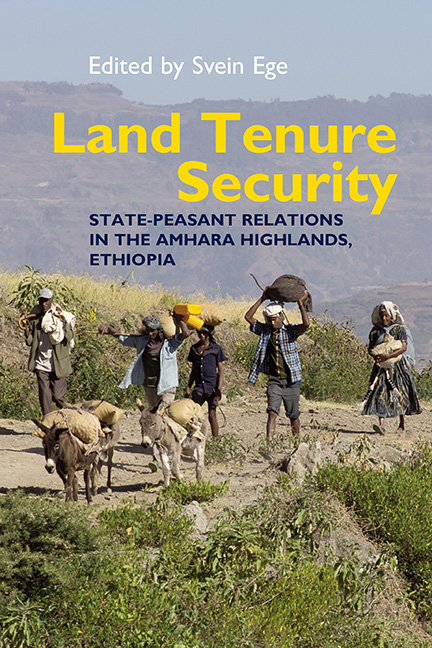Book contents
- Frontmatter
- Dedication
- Contents
- List of Illustrations
- Note on Transliteration
- Dates and Measures
- Contributors
- Preface
- Glossary
- Map
- 1 Introduction
- 2 Peasant Land Tenure: A Critical Review
- 3 The Dersha System: Rethinking Land Tenure under the Därg
- 4 Land Tenure in Gojam under the Därg
- 5 Land Tenure in Baba Säat, North Wälo
- 6 Rich and Poor: Land and Wealth in Mäqét, North Wälo
- 7 Rural Land and Urban Aspirations: Future Orientation in a Time of Change
- 8 An Unstable Land Tenure System
- 9 Conclusion
- Postface
- Select Bibliography
- Index
- Eastern African Studies
5 - Land Tenure in Baba Säat, North Wälo
Published online by Cambridge University Press: 26 March 2019
- Frontmatter
- Dedication
- Contents
- List of Illustrations
- Note on Transliteration
- Dates and Measures
- Contributors
- Preface
- Glossary
- Map
- 1 Introduction
- 2 Peasant Land Tenure: A Critical Review
- 3 The Dersha System: Rethinking Land Tenure under the Därg
- 4 Land Tenure in Gojam under the Därg
- 5 Land Tenure in Baba Säat, North Wälo
- 6 Rich and Poor: Land and Wealth in Mäqét, North Wälo
- 7 Rural Land and Urban Aspirations: Future Orientation in a Time of Change
- 8 An Unstable Land Tenure System
- 9 Conclusion
- Postface
- Select Bibliography
- Index
- Eastern African Studies
Summary
The previous chapters dealt with land tenure in the more central parts of the Amhara region. In this chapter, we turn to the extreme highlands of North Wälo, which is less accessible and of less interest to the government due to its low agricultural potential. Here land tenure followed a different path from the southern part of the Amhara region, both under the Därg and afterwards. There was no initial complete registration of households and their lands. Consequently, the dersha system did not develop. Neither does the redistribution theory provide a good fit. Instead, this is a case of standard family-based land tenure with a typical patriarchal flavour. However, a series of reforms led to a step-wise reduction in inequality during the Därg period. This was taken one step further by the EPRDF land redistribution in 1991. From the available descriptions of this reform, this appears to have been a very real redistribution that established exceptional equality; but it also seems to have created much uncertainty about government land policy, evidenced in the way peasants talked about their land holdings. For them, new rounds of land redistribution in the future were probably not off the table.
There are only a few studies of land tenure in northern Ethiopia after the land reform. For the Därg period, the only major exception I can think of is the study from South Wälo by Teferi Abate (1998). There are some unpublished M.A. theses at Addis Ababa University, and a number of published studies touch on the subject but do not make it their focus. The TPLF-EPRDF period is apparently much better covered, although here the literature tends to fall into one of two camps: the pro-TPLF studies from Tegray (Young 1997; Hendrie 1999; Chiari 2003), and the rather critical studies of the 1997 land redistribution in the Amhara Region.
There is reason to question what we know, or rather believe we know, about land tenure in northern Ethiopia. This specifically applies to such key elements as the widespread understanding of rest as the general land tenure system in the north; of rest as communal land tenure; that the Därg period was characterized by periodic land redistribution; that the peasants were eagerly awaiting the EPRDF land reform; or that women lacked land rights until they were liberated by the EPRDF.
- Type
- Chapter
- Information
- Land Tenure SecurityState-peasant relations in the Amhara Highlands, Ethiopia, pp. 80 - 97Publisher: Boydell & BrewerPrint publication year: 2019



